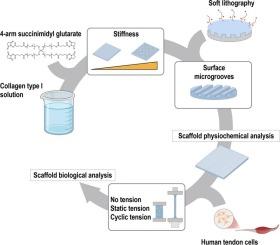Collagen scaffold anisotropy and static tension maintain human tendon cell phenotype in culture
IF 6
2区 医学
Q2 MATERIALS SCIENCE, BIOMATERIALS
Materials Science & Engineering C-Materials for Biological Applications
Pub Date : 2025-08-30
DOI:10.1016/j.bioadv.2025.214483
引用次数: 0
Abstract
Biophysical in nature signals, due to their simplicity in implementation, are at the forefront of research and innovation to control tendon cell function in vitro. In this work, we first assessed the influence of substrate rigidity and surface topography on human tendon cells using differentially crosslinked planar and grooved collagen scaffolds. We identified the 0.5 mM 4-arm polyethylene glycol succinimidyl glutarate concentration as the optimal one to maintain basic cell function. All crosslinked grooved substrates induced bidirectional cell and synthesised matrix orientation, without bringing about a noteworthy change in gene expression. We subsequently subjected the 0.5 mM 4-arm polyethylene glycol succinimidyl glutarate crosslinked planar and grooved collagen scaffolds to no tension, static tension and cyclic tension. Basic cell function, protein synthesis and gene expression analyses experimentation identified the static tension to have beneficial effects in human tendon cell function. Collectively, this study advocates the use of combined biophysical cues to maintain physiological cell function.

胶原支架的各向异性和静态张力维持了培养中人肌腱细胞的表型
生物物理信号,由于其简单的实施,是研究和创新的最前沿,以控制肌腱细胞的功能在体外。在这项工作中,我们首先使用差异交联的平面和沟槽胶原支架评估了基质刚度和表面形貌对人肌腱细胞的影响。我们确定0.5 mM 4臂聚乙二醇丁二酰戊二酸盐浓度是维持细胞基本功能的最佳浓度。所有交联沟槽底物均诱导细胞双向定向和合成基质定向,而基因表达没有明显变化。随后,我们将0.5 mM四臂聚乙二醇丁二酰戊二酸交联的平面和沟槽胶原支架分别置于无张力、静态张力和循环张力下。细胞基本功能、蛋白质合成和基因表达分析实验表明,静张力对人体肌腱细胞功能有有益的影响。总的来说,本研究提倡使用联合生物物理线索来维持生理细胞功能。
本文章由计算机程序翻译,如有差异,请以英文原文为准。
求助全文
约1分钟内获得全文
求助全文
来源期刊
CiteScore
17.80
自引率
0.00%
发文量
501
审稿时长
27 days
期刊介绍:
Biomaterials Advances, previously known as Materials Science and Engineering: C-Materials for Biological Applications (P-ISSN: 0928-4931, E-ISSN: 1873-0191). Includes topics at the interface of the biomedical sciences and materials engineering. These topics include:
• Bioinspired and biomimetic materials for medical applications
• Materials of biological origin for medical applications
• Materials for "active" medical applications
• Self-assembling and self-healing materials for medical applications
• "Smart" (i.e., stimulus-response) materials for medical applications
• Ceramic, metallic, polymeric, and composite materials for medical applications
• Materials for in vivo sensing
• Materials for in vivo imaging
• Materials for delivery of pharmacologic agents and vaccines
• Novel approaches for characterizing and modeling materials for medical applications
Manuscripts on biological topics without a materials science component, or manuscripts on materials science without biological applications, will not be considered for publication in Materials Science and Engineering C. New submissions are first assessed for language, scope and originality (plagiarism check) and can be desk rejected before review if they need English language improvements, are out of scope or present excessive duplication with published sources.
Biomaterials Advances sits within Elsevier''s biomaterials science portfolio alongside Biomaterials, Materials Today Bio and Biomaterials and Biosystems. As part of the broader Materials Today family, Biomaterials Advances offers authors rigorous peer review, rapid decisions, and high visibility. We look forward to receiving your submissions!

 求助内容:
求助内容: 应助结果提醒方式:
应助结果提醒方式:


